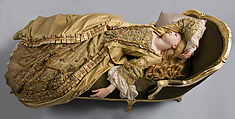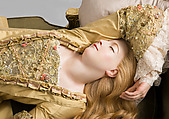Returned to lender The Met accepts temporary loans of art both for short-term exhibitions and for long-term display in its galleries.
Sleeping Beauty
Philippe Curtius Swiss
Not on view
This luxuriously robed woman, sprawled on a velvet divan, is an automatized waxwork whose breast rises and falls subtly, as if she were alive and breathing. Combined with the realism of the figure’s tinted wax, wig, and clothing, the mechanized body seems poised on the threshold between art and life. Lifelike images of swooning and cataleptic women known as Sleeping Beauties became popular forms of fairground entertainment in the eighteenth century. Male onlookers took pleasure in viewing these passive female bodies and determining whether they were real or robotic. The Swiss wax modeler Curtius based this automaton on a figure of public titillation, Louis XV’s famous mistress Madame du Barry.
Due to rights restrictions, this image cannot be enlarged, viewed at full screen, or downloaded.
This artwork is meant to be viewed from right to left. Scroll left to view more.



